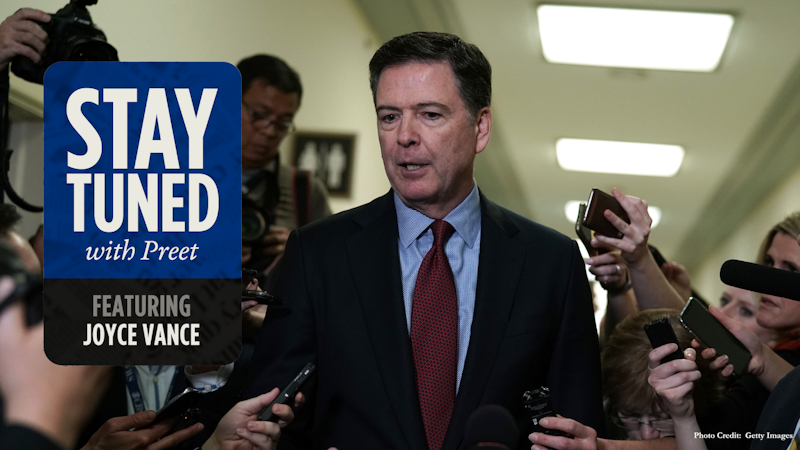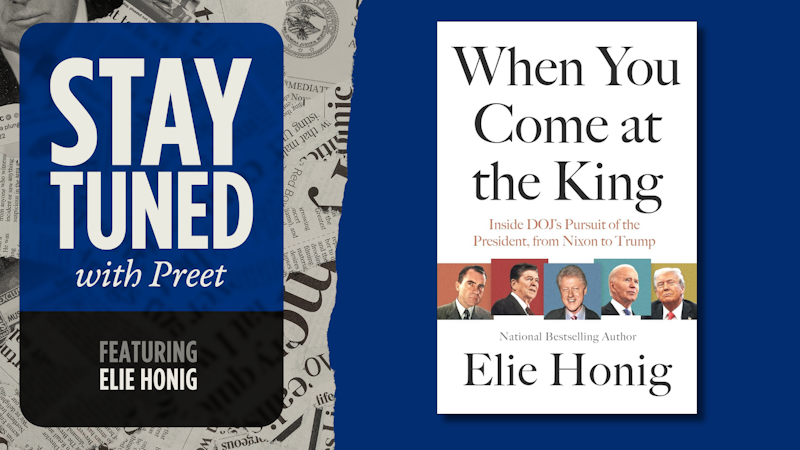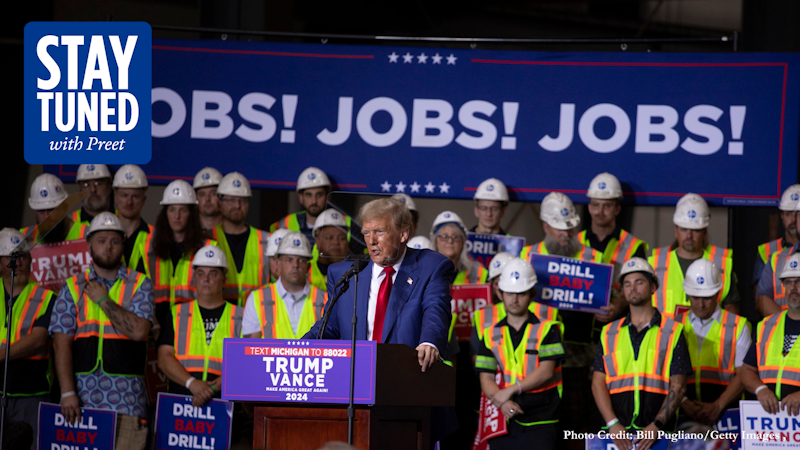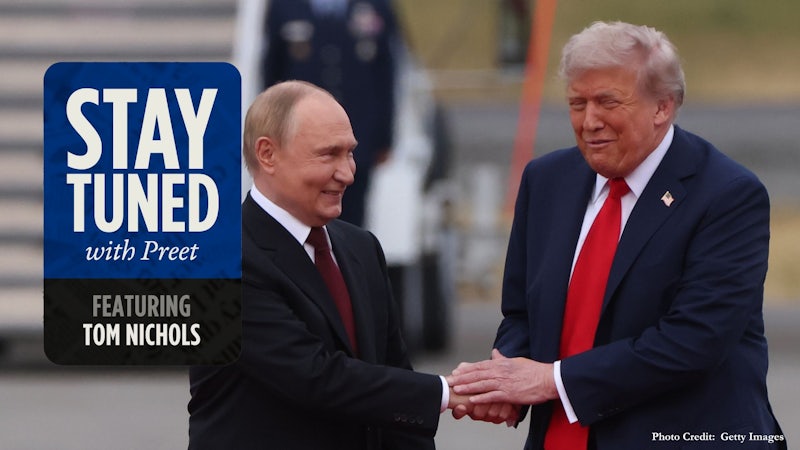Preet Bharara:
From CAFE in the Vox Media Podcast Network, this is Stay Tuned in Brief. I’m Preet Bharara.
Many legal experts were stunned earlier this month when the Supreme Court ruled that Alabama’s new congressional map likely violates Section Two of the Voting Rights Act. Section Two holds that the right to vote shall not be denied or abridged on account of race, color, or previous condition of servitude. What made the decision especially surprising was that its author was Chief Justice John Roberts, who sided with the court’s liberal justices, and Justice Brett Kavanaugh to affirm a law that he had previously voted to weaken.
Today, I’m joined by Abha Khanna, who argued the case before the Supreme Court on behalf of one of the plaintiffs, a group of Black voters from Alabama. Khanna is a partner at the Elias Law Group, the voting rights firm, founded by Marc Elias, a previous guest on Stay Tuned. Abha Khanna, welcome to the show.
Abha Khanna:
Thank you, Preet. It’s great to be here.
Preet Bharara:
So congratulations on your victory in the Supreme Court.
Abha Khanna:
Thank you.
Preet Bharara:
Can we start with the most basic question? What was the case about? And then we’ll get into strategy and what the decision means.
Abha Khanna:
Sure. This case is a claim brought under Section Two of the Voting Rights Act against Alabama’s 7 District Congressional Map. Section Two prohibits vote dilution based on ethnicity or race. And our claim was that Alabama, which has seven single-member congressional districts, has only one congressional districts in which Black voters have an opportunity to elect their preferred candidates. In a demographic climate after the US census where Black population is as much as 28%, they have only 14% of representation in Congress in the congressional delegation.
And we had to establish that given that the geography, the demography, the racial polarized voting statistics, electoral performance, and a host of other factors, racial, political, social, both historically and contemporaneously, we had to establish that Black voters under the Voting Rights Act are entitled to an additional district where they can elect their preferred candidates.
Preet Bharara:
Did you have to prove under the law that it was an intentional disenfranchisement in Black voters?
Abha Khanna:
No, and that is a very important distinction. Section Two of the Voting Rights Act had been in 1982, Congress specifically made clear that intentional discrimination is not part of plaintiff’s burden and that plaintiffs are free to bring a results-based claim. Basically on the theory that it is not necessary for plaintiffs to prove racism and racist intent and animus in the hearts and minds of the map drawers in order to establish that the resulting law has a discriminatory effect on minority voters.
And then once you’ve established that effect, you can contextualize that with evidence called the totality of circumstances that basically talks about the social, political and reality in the jurisdiction and the extent to which racial politics drives access to the franchise in the jurisdiction. But plaintiffs are not required to make an intentional discrimination showing. And that that’s been a long, for nearly four decades been part of Section Two of the Voting Rights Act, both as articulated by Congress in the statute and as repeatedly reaffirmed by the US Supreme Court in its case law.
Preet Bharara:
Do you recall or do you know what percentage of the population in the Black majority District was Black?
Abha Khanna:
In the existing one?
Preet Bharara:
Yeah.
Abha Khanna:
I believe in the existing district it’s about 55%, maybe 56, something along that line.
Preet Bharara:
And what about the next highest Black proportion population?
Abha Khanna:
That’s the really important point here. Right now under the existing map, congressional District Seven is the only Black majority district with about 55 or 56% Black voting age population. In three surrounding districts, including in the Black Belt area of Alabama, the Black population is about 25 to 30% of the district. So our claim was basically that what you see under Section Two here is what we call packing and cracking, putting a high concentration of Black voters in one district and then diluting their influence across multiple districts outside of that effectively to narrow and limit their ability to elect to a single district and ensure that they cannot join forces in any of the other districts to elect another candidate of their choice.
Preet Bharara:
Right. So if you’re a layperson listening to this and you realize you don’t have to prove intent and given the stats that you provided and the fact that there’s seven districts, 28% total population in the state Black Americans, and they’re packed and cracked, as you said, why was this considered to be an uphill legal battle? It sounds from the fact and the nature of the law that it should have been easy.
Abha Khanna:
Well, let me first talk about what the standard is for plaintiffs in a Section Two case. Make no mistake, it is a demanding standard. You have to prove the geographic compactness and the numerosity of the Black population. You have to prove racially polarized voting and you have to prove a variety of additional factors that makes clear that race and politics are so deeply infused in this jurisdiction that it affects Black access to the franchise. It is a difficult standard to meet and one that is not often met.
But in this case, the district court found that it was not even close. Under the legal standard as provided by Congress and the US Supreme Court for, as I said, nearly four decades, the evidence here was overwhelmingly indicative of a violation of Section Two. When it comes to the question of what were people expecting out of the US Supreme Court particularly where the district court found this was not even a close case. What Alabama tried was to appeal this case not on the facts and the law as it exists, but to appeal this case to the US Supreme Court in an effort to overturn that precedent and upend our long-standing expectations of what the law requires and what the legal standard is.
That’s the legal standard that was applied by the district court and Alabama basically went to the US Supreme Court and said maybe we should change the standard or maybe get rid of Section Two of the Voting Rights Act altogether. Because whatever tests and standard existed for the last multiple decades, we can pretty much cast that off right now and move to a kind of either race blind assumption where plaintiffs are really put back in the position of having to prove racial animus.
Preet Bharara:
So it’s worked recently. It worked with roe and it’s worked with a lot of other things as well.
Abha Khanna:
Exactly. I do think it was a gambit on behalf of Alabama to see if they could try their hand at this particular Supreme Court to say something other than what it has said for 40 years and upend the legal standard. And I think among the punditry, when we look at outside of the legal standard that we’ve already discussed, there was some question about whether or not how this court would rule in this case. And I think it’s really because we probably have all braced ourselves a little bit to expect major upheavals in the law, major upheavals in our expectations, major upheavals in legal precedent.
I know we’ve seen that in other cases in recent years. But ultimately when it comes to the actual opinion handed down in this case, it’s not very remarkable at all. All it says is legal precedent stare decisis, Congress’s text means what it says, and plaintiffs can rely on that the standards that we’ve established for decades.
Preet Bharara:
In another time, fair to say it would’ve been a fairly unremarkable opinion?
Abha Khanna:
In another time, I think it would be an unremarkable opinion. In this time, it is a affirming opinion that there are some laws and standards and fundamental tenants of civil rights and voting rights that we can rely on and rely on the courts to hold true.
Preet Bharara:
Explain why Justice Roberts, the Chief Justice, wanted to write the opinion.
Abha Khanna:
Well, I mean, I can’t get into the heart and mind of Chief Justice Roberts, but certainly Chief Justice Roberts, I know he did author the Shelby County opinion several years ago.
Preet Bharara:
Right. I was going to ask about that. In which the court gutted Section Five of the Voting Rights Act. So how do you square those things and how were your expectations met or defied?
Abha Khanna:
Certainly the opinion in Shelby County was disappointing. Section Five was a huge pillar of voting rights protection for minority voters across the country. But that opinion, Section Five has been the subject, had been the subject of significant dispute between the states and the federal government for a long time. Remember Section Five basically required federal oversight in the first instance when it came to any election laws passed by certain states and jurisdictions who had been kind of flagged in advances as being problematic.
And what Shelby County did is it said, well, the list of states and jurisdictions that we had established in 1965, we need to no longer have the evidentiary basis to presume that what they would enact when it comes to voting is unlawful and require federal oversight. The same principles that animated the dispute over Section five did not, I think, come into play here. And in fact, Chief Justice Roberts in the Shelby County opinion specifically said that the opinion in that case does not affect the nationwide and permanent requirements imposed and obligations imposed by Section Two of the Voting Rights Act.
So while some might have viewed the Shelby County opinion as the beginning of the end for the Voting Rights Act and the Chief Justice’s attempt to kind of whittle away at the Voting Rights Act, there’s language in there that actually says, in cutting down one pillar of the Voting Rights Act, we are endorsing or certainly not cutting down the second pillar, another pillar of the Voting Rights Act. And I think his opinion in this case brings that to bear and says that Section Two does not present any of the same constitutional issues that were raised in the Section five context.
And in fact, the claims brought by the state of Alabama here on appeal were entirely novel, entirely ungrounded in the history text and precedent and not warranted.
Preet Bharara:
So you go into the Supreme Court and you’re preparing for it in the lead up, and obviously in some universe you’re thinking about making the best objective argument you can make, but in the real universe you’re trying to make the best argument that will gain your position five votes and you know you have pretty solidly three votes on the progressive side. How do you about or how did you think about tailoring your arguments to some of the other justices? And were Roberts and Kavanaugh your targets or were there different targets or you were trying to get?
And you also probably knew that Alito and Thomas were not gettable. How’d you think about that strategy?
Abha Khanna:
Yeah, I mean that is always the get right. You always have to think about who are we really speaking to here? And I think we envisioned that we were speaking to most likely Chief Justice Roberts, Justice Kavanaugh, Justice Barrett, who maybe their positions on these issues were a little less clear or less known. And I think one way that I tried to address what I believed might be particularly the Chief Justice’s concern as expressed in Shelby County was to talk about not just how far we’ve come under the Voting Rights Act, but why the Voting Rights Act, Section Two of the Voting Rights Act continues to be necessary in order to maintain the progress we’ve achieved since 1965.
Preet Bharara:
So as we’ve said, one of the justices who voted for your position was Justice Kavanaugh, who seems to have taken the position that precedents that involve statutory interpretation, longstanding statutory interpretation, meaning what do the words of a congressionally passed statute mean, they deserve more deference and more weight than cases that involve the interpretation of the Constitution. Why is that? And does that make sense?
Abha Khanna:
That is an argument that we expressly made in our briefs that not only do principles of legal precedent and stare decisis hold true when it comes to the court’s precedent generally, but particularly in where Congress and the court have essentially communicated through statute and through case law to get onto the same page about what does the federal law mean, what does it require, what are its limits and what are its obligations. That’s where stare decisis is at its height. And so it is an argument that we advanced that said, obviously precedent is not just on our side, but statutory precedent has a unique role when it comes to what the court can do to upend it.
Because it’s really upending the expectations of not just the judiciary, but also the legislation as well. So he did agree with our position on that. I think all the justices in the majority agreed with our position on that. I know that Justice Kavanaugh made a point of noting that he was making that distinction here on the record. I know there’s been lots of speculation as to whether he is speaking to the dissenting justices, whether he’s speaking to his opinion in the Dobbs case, whether he’s speaking to some future opinion that’s coming down.
So I can’t prognosticate as to what the real intent there was, but ultimately he endorsed the argument that we put forward, which is that stare decisis is at its height when the court is interpreting precedent around a settled statute.
Preet Bharara:
What do you think is the point on which you lost Amy Coney Barrett?
Abha Khanna:
That I don’t know. I think it still remains a little bit of a mystery as to what her … It was a mystery, I think, going into the argument what her position was. I think she asked a lot of really great questions during the argument about the key issues, including some of the issues raised by defendants about race blind maps and things like that. I think maybe we’re still getting a read on where she falls when it comes to her position on voting rights, but certainly I think that, I don’t know if she was ever inclined on this issue or if she was particularly intrigued by the state’s novel arguments.
Preet Bharara:
So what is this decision, five, four decision by the Supreme Court mean in practical terms for redistricting either plans in various states or ongoing litigations, many of which you are in charge of?
Abha Khanna:
The effects of this particular decision are immense. In Alabama, we are proceeding towards a remedy map that will allow Black voters an opportunity to elect in an additional district. And we also have pending cases, as you mentioned right now in Louisiana and in Georgia and in Texas. In Louisiana, we actually won another Section Two district on the same idea, same claim in Louisiana’s congressional map on preliminary injunction. And the US Supreme Court stayed that victory pending the decision in Alabama. So what we’ve argued is that the court should send that case back down to the remedy phase in light of Alabama.
Alabama Milligan case made clear that the law is what it is, the law has not changed, and that the Louisiana Court applied that longstanding precedent to the facts of that case and we should proceed forward on that basis. In Georgia, we also had a preliminary injunction hearing asking for an additional minority opportunity district in Georgia’s congressional map. And there the court also found we were likely to succeed on the merits under the law as it exists. It ultimately did not provide the preliminary injunction because during that hearing we had that stay order come down in the Alabama case.
So the court viewed itself as basically timed out at that point. But there’s every reason to believe that the same reasons we were likely to succeed in Alabama, the same reasons that we’re likely to succeed in Louisiana are going to apply in Georgia as well. Now that everybody can go forward on the law as it exists and the facts of each case, we can actually litigate the issues here instead of trying to fight against some fanciful view of the law that the states might have in order to eliminate or diminish their responsibilities under the Voting Rights Act.
Preet Bharara:
So do we know at this point what the map in Alabama will look like in 2024 or not yet?
Abha Khanna:
We don’t know exactly what the contours of the map will look like. There have been a lot of maps produced in the course of litigation, including by us; Illustrative Maps showing how the state could provide an additional opportunity consistent with its own traditional redistricting principles. I think in the next few weeks we’re going to proceed to the remedy phase to see how that map will be drawn. In fact, just yesterday the state of Alabama indicated that the legislature doesn’t intend to reconvene to try to draw a remedial map as early as mid-July.
So we are watching and we are hopeful that that’s an effective remedy. And if we don’t think it is, we’re going to continue to litigate that in court to make sure that the remedy is actually an effective remedy for the wrong that we’ve established.
Preet Bharara:
I need to let you go. So one final question. Could you explain and elaborate on why this is so vitally important in our country?
Abha Khanna:
The protection of minority voting rights is a fundamental civil right and human that we have held firm on for nearly 60 years now. The Voting Rights Act of 1965 was perhaps some of the most seminal legislation in this country that basically recognizes there’s a severe gap when it comes to access to the franchise between minority voters and white majority voters, and that it is incumbent upon the federal government and federal laws to ensure that states are working to bridge that gap and to ensure equality of access. We still have a long way to go, and in some places it’s a longer road than in others.
And I think what this recognizes is that we have made progress because the Voting Rights Act exists. We have made progress in this country because states and jurisdictions are held to legal standards whereby they cannot ignore minority populations. And to the extent we have made that progress, it’s because of this legislation, it’s because of this legal precedent, and it’s not something we can just throw away in the hopes that that progress will maintain. But it’s something that really does hold states and jurisdictions feet to the fire to say that there are segments of their population that they just cannot continue to ignore.
Preet Bharara:
Abha Khanna, congratulations again on your Supreme Court victory. Thank you for your work and thanks for being on the show.
Abha Khanna:
Thank you, Preet.
Preet Bharara:
For more analysis of legal and political issues making the headlines, become a member of the CAFE Insider. Members get access to exclusive content including the weekly podcast I co-host with former US attorney, Joyce Vance. Head to cafe.com/insider to sign up for a trial. That’s cafe.com/insider. If you like what we do, rate and review the show on Apple Podcasts or wherever you listen. Every positive review helps new listeners find the show. Send me your questions about news, politics and justice. Tweet them to me @PreetBharara with the hashtag, #askpreet.
Or you can call and leave me a message at 669-247-7338. That’s 669-24-PREET. Or you can send an email to letters@cafe.com. Stay tuned is presented by CAFE and the Vox Media Podcast Network. The executive producer is Tamara Seper. The technical director is David Tatishor. The senior producer is Adam Waller. The editorial producers are Sam Ozer Staton and Noah Asalai. The audio producer is Nat Wiener, and the CAFE team is Matthew Billy, David Kurlander, Jake Kaplan, Nama Tasha and Claudia Hernandez. Our music is by Andrew Dost. I’m your host, Preet Bharara.
Stay tuned.

































